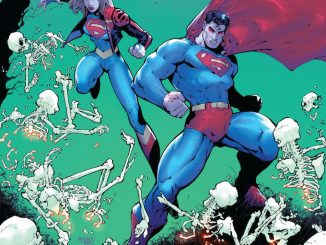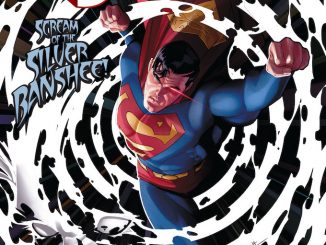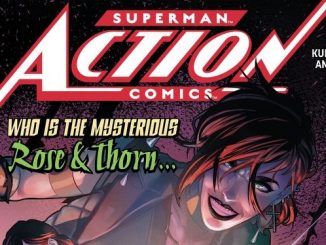By Craig Boehmer
The following is Part Two of a series in which I analyze how Superman is used in team situations across various media.
Part One was an analysis of The JLA by Grant Morrison Omnibus, available wherever you purchase your comics. Read Part One here.
Here in Part Two I will look at Dan Jurgens’ short tenure as the writer for Justice League.
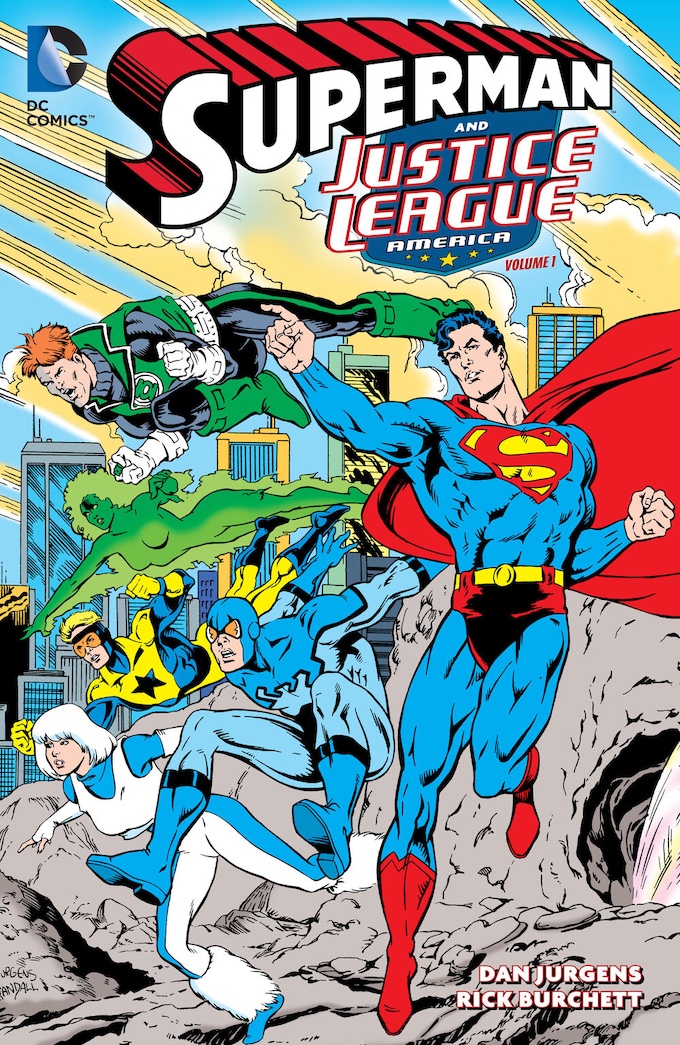
Superman and the Justice League
The early post-crisis era of Justice League began with writer J.M. DeMatteis and artist Keith Giffen. Due to publishing constraints at the time on Superman, Wonder Woman, and The Flash, the original creative team was unable to use those characters. As a result, the book focused on lesser-known superheroes and Batman. The initial team consisted of Batman, Black Canary, Blue Beetle, Captain Marvel, Doctor Fate, Doctor Light, Guy Gardner, Martian Manhunter, and Mister Miracle. Though not all these characters would stay past the first arc. By issue #61 Dan Jurgens took over as writer. When Dan Jurgens took over the run, the previous constraints on using Superman were gone, so one of his first acts as writer was to bring Superman over as the new leader of the Justice League. The art chores were split between Jurgens and Rick Burchett, who acted as the series embellisher/finisher. This review will focus solely on his time as writer on Justice League of America, and not on his New 52 series Justice League International (Vol. 3).
“Superman and the Justice League of America” is an interesting read. Superman is not the natural leader of the Justice League that we would see in later years. Early in Jurgens’ first issue, Batman meets with Superman and asks him to be part of the creation of a new Justice League team, the previous one having been disbanded in the prior arc. Superman’s initial reaction is that he can do more good for the world without a team slowing him down. Honestly, this is the most real reaction of a person with Superman’s power set being involved with a team, especially the Justice League of that era. At the time of this story, the potential members of the Justice League of America are Blue Beetle, Booster Gold, Ice, Fire, Guy Gardner, Maxima, and Bloodwynd. While there are some decent power houses on the team, such as Gardner, Maxima, and Bloodwynd, they are hardly a functioning team. Gardner is in peak Gardner form, Maxima is obsessed with gaining Superman as a mate, and Bloodwynd is… well mysterious. The remaining heroes certainly do not have the power levels to keep up with Superman.
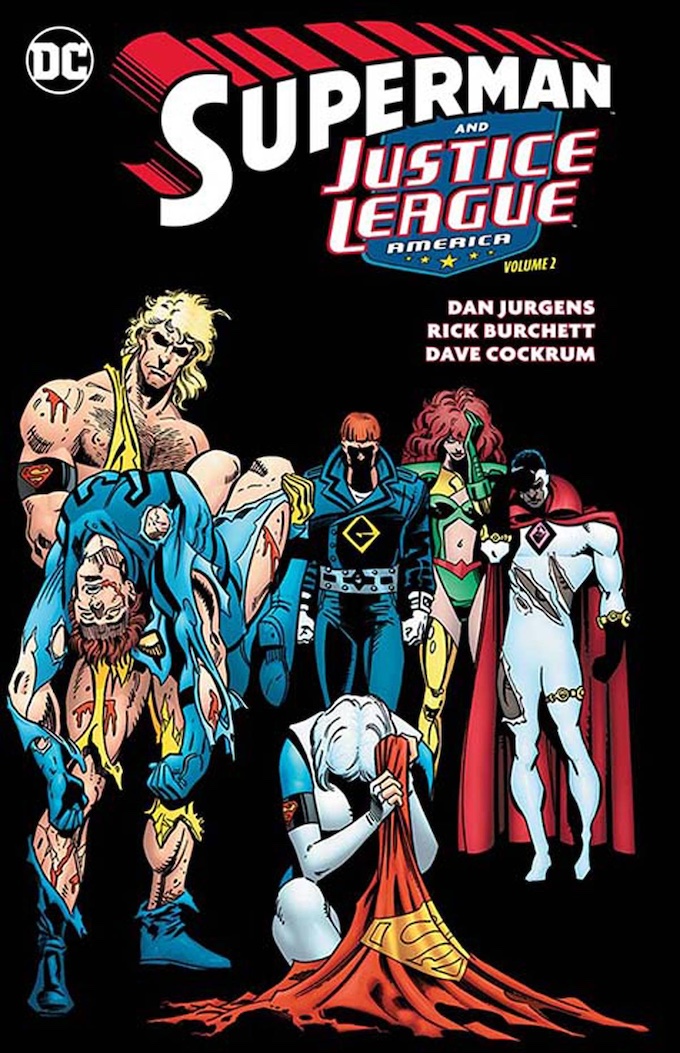
Continuing with the trend set by DeMatteias and Giffen, Jurgens focuses a lot on the interactions between the Leaguers, rather than on major bombastic calamities. The Justice League doesn’t really face off against any major villains until the Death of Superman arc where, spoilers, Superman dies. They are brought together by the Royal Flush Gang attacking a group of diplomats at an amusement park on the East Coast. Superman attempts to deal with the gang, but their new high-tech weaponry proves to be too much for the Man of Steel. It takes the combined might of the former Leaguers to overpower the gang and discover that the real villain is the Weapons Master, who was hired by a Dominator to retrieve Guy’s power ring. Weapons Master is the most recurring villain on this brief run, as he orchestrates the initial attack as a means of observing the heroes’ powers. Later when he confronts them, it is only through the efforts of Bloodwynd that the League is saved. When he again attacks the team, he traps them in the Infinite Void, it is only through the intelligence of Blue Beetle that they are saved. Weapons Master also acts as a manipulator that brings the Justice League into Bloodwynd’s crystal to confront the monster Rott, though this occurs after Death of Superman.
Starbreaker is another villain in this run that the League must face. He originally fought the pre-crisis Justice League, something that he alludes to in the conflict. Starbreaker has used his powers to conquer Maxima’s homeworld of Almerac. The Justice League help Maxima liberate her world from his dictatorship.
The final major big bad of this run is Doomsday. The Death of Superman arc crosses over with the Justice League of America series. JLA members are the first heroes to make contact with the monster, doing so while Superman is busy giving a live t.v. interview for high schools around the USA. The fight with Doomsday is devastating for the JLA. Blue Beetle is beaten into a coma, which becomes the setting for a very strong story arc afterwards. Booster Gold is almost killed and loses all his future gadgetry. Fire and Ice are both beaten nearly to death, Maxima is caught in an explosion and knocked unconscious, Guy Gardner’s body is broken, and Bloodwynd… well Bloodwynd is beaten so badly that he reverts to his true form, which Kord sees right before Doomsday grabs him. Doomsday is devastating to the JLA, they are used as cannon fodder to showcase how powerful he is. Other than these few baddies, the JLA of this era doesn’t deal with any villains that really move the needle.
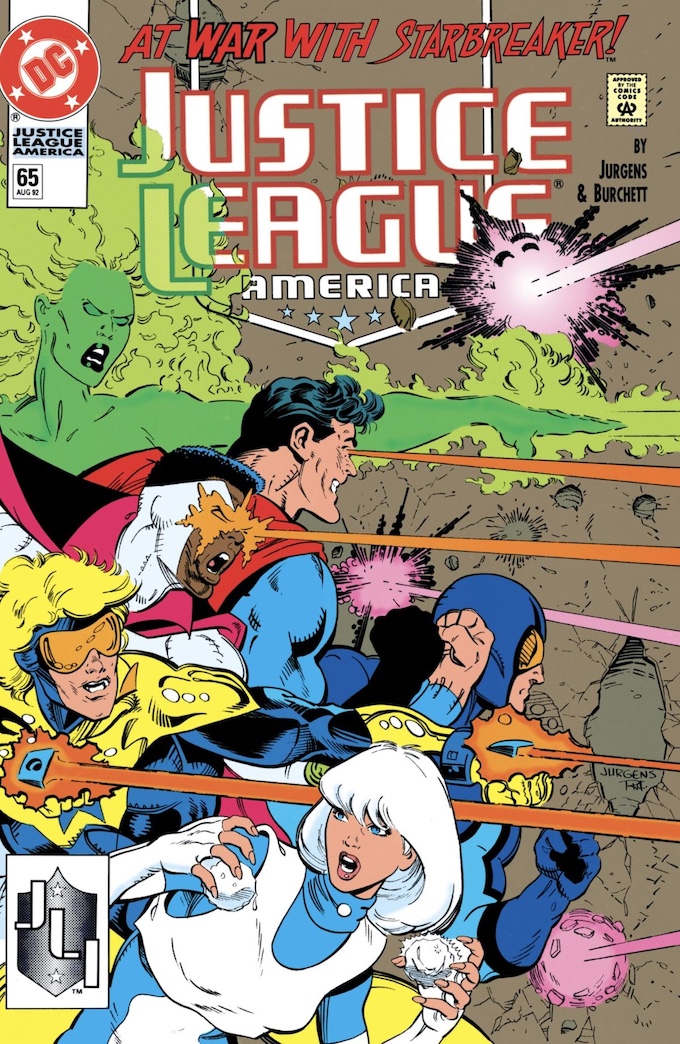
But more important than the bad guys faced is looking at how Superman interacts with other members of the team. Through the brief run Superman is the leader and calm voice of experience. This plays out in interesting ways depending on the other members. Ice develops a significant crush on Superman. She regularly supports his ideas, defers to him, and argues with any other member who disagrees with him. When Superman saves her from Weapons Master, she gushes over him. There is significantly less interactions between Fire and Superman, he pretty much lets her do her own thing, and Ice acts as the liaison between them.
Booster Gold has a complicated history with Superman. The two met quite a few times in the Triangle Era, and their relationship began with Booster wanting to usurp Superman’s role as the premier superhero of Metropolis. Superman vehemently disagrees with Booster’s plan to monetize superheroics but develops a begrudging respect for BG as the veneer of selfishness passes to reveal his heroic heart. By the time the two are on the Justice League together, they have a collegial relationship.
Blue Beetle and Bloodwynd don’t have a lot of moments with Superman in this run. Because the run with Superman as a central piece is so short, some of the relationships are frustratingly stifled. If it had gone on longer, these two would make sense for having strong relationships with Superman.
When Maxima first appeared in the DC universe, she was seeking to make Superman her mate. When she is foiled of this plan, she returns to Almerac. When Brainiac controls War World, she offers to join him in exchange for him sparing her people. As a result, she is with Brainiac during the Panic in the Sky arc that featured Brainiac invading Earth. Seeing Brainiac as he really is, motivates Maxima to become a hero, and leads her to eventually joining the Justice League. Most of her interactions with Superman are still centered on her desire to use him as her mate. Which he repeatedly spurns.
Gardner – oooh boy, Gardner spends most of the time trying to prove he should be the leader. He even abandons them on Almerac because he feels disrespected. When he discovers Ice’s infatuation with Superman, this drives Guy to be even angrier and more dismissive of Superman’s leadership. Superman recognizes the asset that Guy can be for the team but doesn’t seem to trust his ability to check his ego at the door for the sake of the mission.
For this run Jurgens uses Superman as an experienced leader. His primary role is to act as a mentor for the younger or more inexperienced heroes. It takes him some coaxing to accept the role, but once he does it creates an interesting dynamic. As the story progresses, he gains a great deal of respect for these heroes, this is most evident during the high school t.v. interview where he praises his teammates’ heroic nature, and professionalism. Even when he has a chance to critique Guy, he down plays the conflict and praises him. Unfortunately, the arc is cut short by the record-breaking Death of Superman. I love the Death of Superman event, and its analysis of the fallout, but I do wish that we had gotten more stories from Jurgens showcasing Superman in this role of mentor. I think this is a style of story that needs to be revisited, maybe in the future they should bring back a truly TEEN Titans team, or YOUNG Justice team, and allow Superman to act as a mentor for the younger heroes. This would create a very interesting new direction for the Man of Tomorrow. I don’t think it should replace his status in the Superman titles, but rather be an addendum to them and take the pressure off the Superman titles needing to showcase every member of the young Superman family.
Overall, aside from the brief length of the run, Jurgens’ “Superman and the Justice League of America” gave Superman fans in the early nineties a chance to see their hero in a different environment. While the conflicts may not have all been earth shattering, and for the most part the villains are lack lustre, it is a fun read that showcases great Superman character moments.


